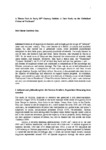Mostrar o rexistro simple do ítem
A Theme Park in Early 20th Century Galicia: A Case Study on the Globalized Visions of “Indianos”
| dc.contributor.author | Cardesín Díaz, José María | |
| dc.date.accessioned | 2025-01-24T16:41:33Z | |
| dc.date.available | 2025-01-24T16:41:33Z | |
| dc.date.issued | 2018 | |
| dc.identifier.citation | Cardesín Díaz, J.M. (2018). A Theme Park in Early twentieth Century Galicia: A Case Study on the Globalized Visions of “Indianos”, In R. DePalma and A. Pérez-Caramés (eds.). Galician Migrations: A Case Study of Emerging Super-diversity. (pp. 63-79). Springer International Publishing AG. https://doi.org/10.1007/978-3-319-66305-0_6 | es_ES |
| dc.identifier.isbn | 978-3-319-66305-0 | |
| dc.identifier.issn | 2522-0721 | |
| dc.identifier.uri | http://hdl.handle.net/2183/40896 | |
| dc.description | This is the accepted manuscript of the document: Cardesín Díaz, J.M. (2018). A Theme Park in Early twentieth Century Galicia: A Case Study on the Globalized Visions of “Indianos”. Published in: R. DePalma and A. Pérez-Caramés (eds.). Galician Migrations: A Case Study of Emerging Super-diversity. Migration, Minorities and Modernity vol. 3. Springer International Publishing AG. https://doi.org/10.1007/978-3-319-66305-0_6 | es_ES |
| dc.description.abstract | [Abstract]: Memories of migration to America used to highlight the image of “Indianos”, those who returned wealthy. They were bearers of a deficit in cultural and symbolic capital, but also carried out a globalized vision; some promoted philanthropic enterprises in their birth place, particularly hundreds of schools. Our study focuses on two of them, the brothers Juan and Jesús García Naveira, who returned to Galicia in 1893. In the small town of Betanzos they financed the construction of schools, trade union centres, and hospices. Moreover, they built a theme park, the “Pasatiempo” (“Leisure Gardens”): on 90,000 m2 of land they built and laid out gardens, a zoo…… and dozens of sculptural scenes that constituted a compendium of the knowledge and Western architectural and artistic heritage. The Park was an act of self-affirmation of those self-made men, a compilation of their self-taught education and their travels through America, Europe and North Africa. However, it documented also their faith in the capacity of technology and education to support human progress: its conceptual design was carried out under the advice of a follower of Pestalozzi and of the Spanish “Institución Libre de Enseñanza” (“Free Educational Institution”); and it was conceived not only as a recreational space, but also as a place where students from schools could learn. | es_ES |
| dc.language.iso | eng | es_ES |
| dc.publisher | Springer International Publishing AG | es_ES |
| dc.relation.ispartofseries | Migration, Minorities and Modernity vol. 3 | es_ES |
| dc.relation.uri | https://doi.org/10.1007/978-3-319-66305-0_6 | es_ES |
| dc.title | A Theme Park in Early 20th Century Galicia: A Case Study on the Globalized Visions of “Indianos” | es_ES |
| dc.type | book part | es_ES |
| dc.rights.accessRights | open access | es_ES |
| dc.identifier.doi | 10.1007/978-3-319-66305-0_6 | |
| UDC.coleccion | Investigación | es_ES |
| UDC.departamento | Socioloxía e Ciencias da Comunicación | es_ES |
| UDC.grupoInv | Grupo de Estudos Territoriais (GET) | es_ES |
Ficheiros no ítem
Este ítem aparece na(s) seguinte(s) colección(s)
-
Investigación (FSOC) [405]






